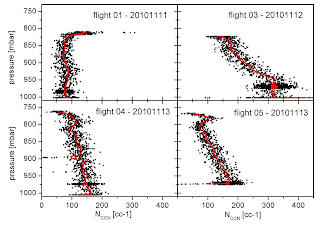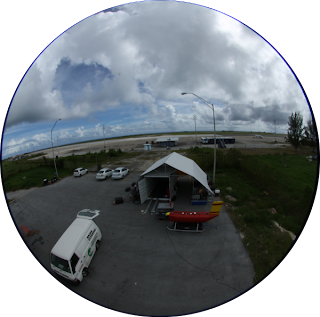 The last measurement flight during our first Barbados campaign was done on Saturday (27.11.). As the picture shows two low cloud levels were present: one at ~600 m and a secon one at ~ 1900 m. After take-off we flew ~ 60 m above sea level to the south. There, we started a vertical profile up to 8000 ft to the east. Due to strong wind from the east, the ground speed was almost zero. During the profile, we passed both cloud layers and decided to perform measurements in both of them. We started with a horizontal leg in the upper cloud layer, followed by few vertical profiles through this layer.
The last measurement flight during our first Barbados campaign was done on Saturday (27.11.). As the picture shows two low cloud levels were present: one at ~600 m and a secon one at ~ 1900 m. After take-off we flew ~ 60 m above sea level to the south. There, we started a vertical profile up to 8000 ft to the east. Due to strong wind from the east, the ground speed was almost zero. During the profile, we passed both cloud layers and decided to perform measurements in both of them. We started with a horizontal leg in the upper cloud layer, followed by few vertical profiles through this layer.After that, we went down and tried to catch some of the low-level cumuli without the second layer above. This was difficult to realize since there were only few of these clouds in the range we could reach within our flight time. But we got some and the quicklook showed obviously some particle bursts at cloud edges.
That was the last measurement flight for this year, but we are planning to come back next year!
Bye, bye barbados! We enjoyed the last month and our stay here and collected enough exciting data to spend the whole german winter with them...














































